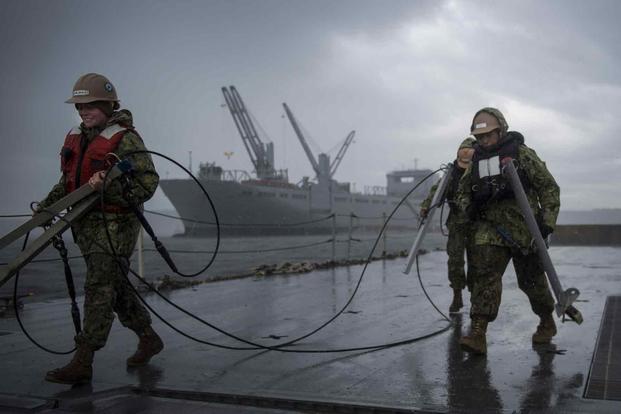As U.S. soldiers and sailors begin construction of the pier that the Biden administration hopes will provide a critical lifeline of aid to war-torn Gaza, military leaders are trying to assure critics that American troops will be well-defended from attack and aid groups that that same protection won't endanger them and their work.
In a briefing Thursday, a senior military official said that "at-sea assembly" of parts of the pier began earlier that day, with military planners anticipating the structure will be ready to start bringing in humanitarian aid in early May.
Also on Thursday, Pentagon spokesman Maj. Gen. Pat Ryder confirmed to reporters that a mortar attack hit the shoreline earlier this week at the location that will eventually become the site of the pier, but caused only "minimal damage."
Read Next: Corps Identifies Camp Pendleton Marine Killed During 'Routine' Operations
That attack has given critics of the mission -- which uses a system called Joint Logistics Over the Shore, or JLOTS -- ammunition to argue that it will place around 1,000 U.S. service members' lives in jeopardy. That total represents a combination of U.S. security and logistics personnel needed to move supplies while providing protection for those in uniform.
Sen. Roger Wicker, R-Miss., the highest-ranking Republican on the Senate Armed Services Committee, said that the attack "was unfortunate but predictable" and argued that "the risk to Americans will only intensify" in a statement released earlier this week.
"President Biden should never have put our men and women in this position, and he should abandon this project immediately before any U.S. troops are injured," argued Wicker, who has been a critic of the plan since it was first announced.
The senior military official who briefed reporters Thursday, however, said that U.S. Central Command doesn't believe "that the attack had anything to do with the JLOTS mission or delivery of humanitarian assistance from the sea."
No U.S. government official has publicly said whether Hamas is responsible for the attack.
The official also said that the Israeli Defense Forces has "a brigade -- thousands of soldiers -- plus Israeli navy ships and Israeli air force that are dedicated to force protection of this operation" and "forces from U.S. European Command and U.S. Naval Forces Europe are also assigned to support."
The official noted that the closest any U.S. troops will come to shore will be "several hundred meters" -- the length of the pier that will be sticking out from the Gaza coast. The trucks that will drive the aid off the U.S. watercraft and onto land will be manned by a non-American "third party" that the official did not identify.
On Friday, Chairman of the Joint Chiefs Gen. Charles "C.Q." Brown told reporters that the Israelis will create "a buffer zone or a bubble out around the distribution area and the pier to keep the threat away from our forces ... but also from the distribution of the aid."
"If that's not protected, then it interrupts the distribution of aid that's so important to the citizens of Gaza," Brown added.
While the Israeli military presence is likely meant to assure critics like Wicker and other Senate Republicans that the U.S. forces will be well protected, their presence also brings concerns for aid workers who will likely play a key role in getting the aid to Gazans once it is ashore.
At the beginning of the month, Israeli forces conducted repeated airstrikes on a World Central Kitchen convoy of aid workers, killing seven.
"Those who approved the strike were convinced that they were targeting armed Hamas operatives and not WCK employees," said a subsequent Israeli investigation, which was released just days later, before adding the incident stemmed "from a serious failure due to a mistaken identification, errors in decision-making, and [it was] contrary to the Standard Operating Procedures."
The U.N. Security Council also noted in the days following the deadly attack that at least 224 humanitarian workers had been killed in the Israel-Hamas war since it began last October, and this total is "more than three times as many humanitarian aid workers killed in any single conflict recorded in a single year."
Brown said that the WCK strike has been a point of conversation for him with his Israeli peers and acknowledged that it has had a chilling effect on outside aid workers coming forward to help with the effort.
Once the mission gets going, military officials say that it will offer a substantial increase in the amount of aid that will be able to flow into Gaza.
The senior military official who spoke with reporters Thursday said that they expect the initial throughput to begin at "about 90 trucks a day … and then quickly scale up to 150 trucks a day."
The official noted that, over the past two weeks, the daily average aid coming into Gaza over the land crossings -- which were largely shut until after the deadly WCK strike -- have been "about 220 trucks a day."
"This additional throughput from the sea represents a significant increase of lifesaving aid," the official said.












